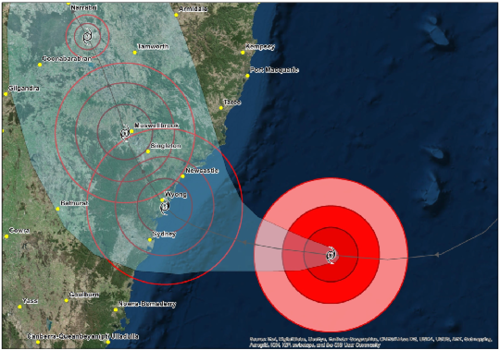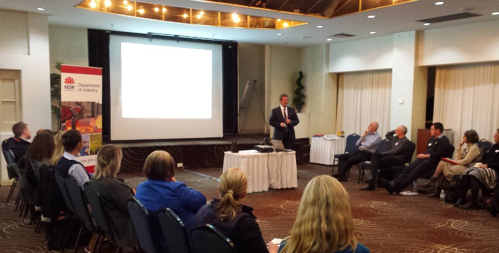Hunter and Central Coast community disaster resilience forums – June 2016
Neil Dufty, Molino Stewart Pty Ltd
Article
Emergency events in the Hunter and Central Coast regions of NSW over 2015-2016 showed there was an immediate need to improve how communities plan for and recover from such events. Community service organisations, businesses and primary producers needed to fully understand the roles of emergency services and plan ahead to maintain continuity during disasters.
A Project Task Group was set up of emergency services agencies to develop and deliver a series of community forums specifically looking at these needs. The forums were held during June 2016 and, according to participants, were very effective. There was strong support by participants for even more opportunities to engage with local emergency agencies and for resilience-related learning.
What is a disaster-resilient community?
A disaster-resilient community is one where residents, non-government organisations (NGO) and businesses work in partnership with government and emergency services agencies before, during and after emergency events. These relationships mean community resilience activities are informed by local knowledge and complement the existing work of emergency services agencies.
Natural weather events over 2015-2016 in the Hunter and Central Coast regions of NSW put community disaster resilience at the forefront of planning for many agencies, NGOs and businesses. Following the devastating storms experienced in the regions in April 2015, the Regional Recovery debrief highlighted the lack of knowledge in the community, particularly among local NGOs, of the roles and responsibilities of the various agencies in disaster response and recovery.
It is important that the NGO sector, community leaders and businesses are aware of emergency management arrangements and that they have plans in place to maintain business continuity during emergencies and disasters. It is also imperative that community service providers and community leaders work together effectively in the local area.
Taking an inter-agency approach helps the NGO sector, business and community leaders by providing relevant and usable information and resources that support community resilience-based planning.
With this in mind, the Project Task Group was formed with representatives from:
- NSW Family and Community Service
- NSW State Emergency Services
- NSW Department of Premier and Cabinet (Hunter and Central Coast)
- NSW Police Regional Emergency Management Officer with direct links to local councils via local Emergency Management Officers
- NSW Department of Industry
- NSW Office of Emergency Management
- NSW Department of Primary Industries
- Hunter New England Area Health.
The Project Task Group delivered a series of community forums for NGOs, businesses and primary producers operating in the regions. The NSW Department of Premier and Cabinet coordinated and organised the forums with Molino Stewart Pty Ltd designing and facilitating the events. Local business consultant, Peter Hollingsworth, presented on business continuity.
There were four objectives of the forums:
- To explain the roles and responsibilities of emergency services providers across preparedness, response and recovery.
- To stress the importance of business continuity planning.
- To provide a practical business continuity planning tool.
- To examine ways that NGOs and other groups can best coordinate recovery in the region.
Methodology
The Project Task Group met several times prior to the forums to consider design and organisation. As facilitator, I consulted with agency representatives from the Project Task Group to understand issues relating to the forum objectives and obtain local knowledge.
The forums were designed to be interactive and thought-provoking. Forum design was:
- A scenario planning exercise (see Figure 1) based on a fanciful ‘Tropical Cyclone Hunter’ that hit the region. The scenario allowed emergency services providers to discuss their roles with forum participants as the ‘disaster’ progressed from preparedness, response to recovery.
- Explanation of how to use the business continuity planning tool provided to participants as an Excel spreadsheet.
- Small group problem-solving activity where participants shared their experiences and identified ways to improve continuity planning and services to clients during and after disasters.
- Videos of examples of good practice in community disaster resilience.
Three forums were held during June 2016 at the Central Coast (Wyong with 22 participants), in the Lower Hunter (Maitland with 31 participants) and the Upper Hunter (Muswellbrook with 17 participants).
Figure 1: The mock ‘Tropical Cyclone Hunter’ used in the scenario exercise.


Peter Hollingsworth provides an explanation of the business continuity planning tool at the forum in the Lower Hunter. Image: Colin Perry
Evaluation
The forums were evaluated using:
- quantitative participant responses using Likert scale closed questions on a feedback sheet
- qualitative participant responses using open questions on the feedback sheet
- reflections by members of the Project Task Group.
The quantitative evaluation provided the following results:
- 94 per cent of respondents felt the forum met their expectations
- the majority of respondents (58 per cent) strongly agreed that the forum helped them understand the roles of agencies in local emergencies and disasters
- over 90 per cent of respondents either strongly agreed or agreed that the forum provided a useful tool for continuity planning
- over 80 per cent of respondents either strongly agreed or agreed that they learnt ways to better coordinate recovery and to help their clients
- almost all respondents (97 per cent) thought the forum was well facilitated.
The qualitative evaluation explored what worked, what didn’t work and what could be improved. Popular responses for ‘what worked’ at the forums included a better understanding of the roles of emergency services, better understanding of continuity planning, and networking with other NGOs and with emergency services agencies.
The few responses for ‘what didn’t work’ indicated that more interactive sessions on business continuity planning and looking at ways to improve relationships between organisations would be beneficial. According to the participants, the main way the forum could be improved was to have greater attendance from the business community and from primary producers (most participants were from NGOs, local councils and emergency services agencies). One way identified to achieve this was to hold the forum in conjunction with other events specifically for businesses and primary producers.
The Hunter and Central Coast Community Resilience forums had clear objectives and most forum participants indicated they learnt more about the roles of emergency services and built their resilience capabilities using the business continuity tool. In essence, participants felt the forums helped them better plan for and coordinate activities during response and recovery and be better prepared to help their clients.
The attendance levels at the forums were less than expected by both participants and the Project Task Group. In particular, there was little or no attendance from primary producers and business groups. However, there was strong support by participants and the Project Task Group to have further opportunities for engagement with emergency services agencies and for resilience-related learning.


